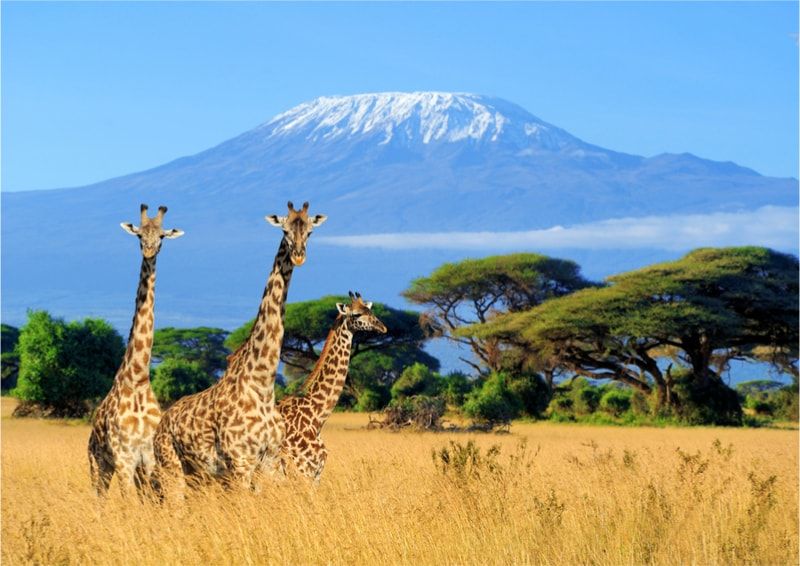Kilimanjaro: Multi-day Trips and Tours from Nairobi
As the world’s highest free-standing mountain, Kilimanjaro needs no introduction. This natural phenomenon is known across the globe and is a spot on many travelers' bucket list.
Whether you wish to participate in a game drive while admiring views over its lofty slopes or hike this challenging terrain yourself, you can do so on a multi-day trip to Kilimanjaro from Nairobi.
As the world’s highest free-standing mountain, Kilimanjaro needs no introduction. This natural phenomenon is known across the globe and is a spot on many travelers' bucket list.
Whether you wish to participate in a game drive while admiring views over its lofty slopes or hike this challenging terrain yourself, you can do so on a multi-day trip to Kilimanjaro from Nairobi.

(0/24) checking Musement...
As the world’s highest free-standing mountain, Kilimanjaro needs no introduction. This natural phenomenon is known across the globe and is a spot on many travelers' bucket list.
Whether you wish to participate in a game drive while admiring views over its lofty slopes or hike this challenging terrain yourself, you can do so on a multi-day trip to Kilimanjaro from Nairobi.
Despite the sizable distance between the two locations, these excursions are simple to arrange and are bound to be great fun for the whole family.

Here's all you need to know about Kilimanjaro, one of the most exciting multi-day trips from Nairobi.
How to get to Kilimanjaro from Nairobi?
Kilimanjaro is located within the Kilimanjaro region of Tanzania, close to the Kenyan border. The national park it is situated in is approximately 250 kilometers from Nairobi.
From Nairobi to Kilimanjaro by car
The journey to Kilimanjaro by car takes just over 4 hours and begins by heading out of Nairobi in a south easterly direction along the A104.
You’ll then merge onto the A109 — also known as Mombasa Road — which you’ll follow as far as Emali, before following the C102, which leads you over the border and into Kilimanjaro National Park.
From Nairobi to Kilimanjaro by public transport
Those who don’t have access to a car can instead make the jaunt to Kilimajaro via public transportation. Those looking for the quickest option can fly from Nairobi to Kilimanjaro International Airport and then take a local bus to the national park.
Alternatively, if you’re looking for a cheaper option, you can board one of Nairobi’s shuttle buses, which run daily and transport you as far as Moshi. From here, you can hire a local taxi to complete the final leg of your journey.
Guided tour to Kilimanjaro from Nairobi
Another option is to book a guided excursion to Kilimanjaro and let someone else take care of the transportation details for you. These range from single day tours, lasting around 13 hours, to multi-day trips, lasting from 3 to 8 days.
You’ll typically enjoy a convenient accommodation pickup service, making for a seamless trip.
To benefit from this, you’ll simply select your hotel from a dropdown list upon booking and, on the day of your excursion, await collection from a friendly guide at a predetermined time.
How much does the entrance ticket to Kilimanjaro cost?
The entrance fee for Kilimanjaro National Park is as follows. You should bear in mind that this cost is exclusive of a mandatory 18% government tax.
- Non-East African adults: US$70
- Non-East African children aged 5 to 15: US$20
- Resident adults: US$35
- Resident children aged 5 to 15: US$10
- East African/ Tanzanian adults: TZS10,000 (US$4)
- East African/ Tanzanian children aged 5 to 15: TZS2,000 (US$1)
What is the typical itinerary?
The itinerary of Kilimanjaro multi-day trips varies significantly depending on how long your chosen tour lasts, as well as the main activity. If you decide to book a day trip, you won’t set foot on the mountain itself. Instead, you’ll travel to Amboseli National Park, which overlooks Kilimanjaro, and participate in a game drive.
On these excursions, you can expect to spend around 8 hours of the day driving to and from your destination, however, the journey is exceptionally scenic, and the hours typically fly by.
Once in Amboseli National Park, you’ll remain inside your vehicle for your own safety as you appreciate the spectacular array of wildlife that calls the reserve home.
There will be a designated lunch break, during which you can purchase a local meal or enjoy a picnic with a view. Then, you can choose to visit a local tribe before returning to Nairobi.
Those who are uninterested by a safari or are simply looking for a challenge, may instead choose a multi-day tour to Kilimanjaro itself and ascend its steep slopes.
There are several routes to choose between, depending on your own fitness level and how much time you have to spare, and you’ll slowly make your way to the summit over several days, resting overnight at climber’s huts on the way up.
What kinds of tours are available to go to Kilimanjaro?
You can choose between an excursion that lasts just a few hours or a multi-day tour to Kilimanjaro, depending on how much time you have to spare on your African adventure.
Day tours to Kilimanjaro plus Amboseli Park from Nairobi

This Kilimanjaro day tour is the ideal way for those with a limited itinerary to explore Tanzania’s most iconic destination — Kilimanjaro. Starting your day early, you’ll board a comfortable vehicle and relax as you drive through the spectacular scenery of East Africa as the sun rises.
Upon arrival at Amboseli National Park, you’ll participate in a game drive, during which you’ll enjoy sweeping views over Kilimanjaro, which stands at almost 5,900 meters high.
While you can never know in advance which animals you’ll spot on a safari, you’re likely to see four of the Big Five in the park — Elephants, lions, leopards and buffalos. Enjoy a local lunch before driving back through Amboseli to admire this wildlife-filled habitat once more before returning to Nairobi.
Those who wish to extend their adventure can do so by upgrading to visit Maasai Village where they can discover tribal life in Tanzania.
6-Day Marangu Route trip to Kilimanjaro from Nairobi
Alternatively, those wishing to dive headfirst into exploring this breathtaking corner of the world can do so on a multi-day trip to Kilimanjaro from Nairobi.
You’ll take the Marangu route, which is known as one of the easiest ways to ascend the mountain, although you can still expect to be challenged as you take on this adventure.
You’ll begin by traveling to Moshi — known as the gateway to Kilimanjaro National Park — where you’ll wander the town to discover how the locals live. The following day, you’ll don your hiking boots and begin your climb of Kilimanjaro, passing through flourishing rainforest as you go.
You’ll spend your days slowly trekking up the mountain while your nights will be used to recuperate at several of the huts on route.
On day 5, you’ll reach the summit where you’ll experience an awe-inspiring sunrise and celebrate making it up the world’s tallest free-standing mountain. From there, you’ll spend the final day of your Kilimajaro multi-day tour making your way back to ground level to continue on with your vacation.
How much does a multi-day trip to Kilimanjaro from Nairobi cost?
Day trips to Kilimanjaro cost US$290 per adult, while children aged 13 to 17 cost between US$50 and US$60 each. Children between the ages of 4 and 12 benefit from a further reduction, bringing their ticket price down to US$30 each, and children under 4 cost just US$20 each.
You can expect to be part of a large group capped at 99 visitors and your excursion includes the services of a professional tour guide, as well as drinks throughout the day. However, the entrance fee to Kilimanjaro National Park is at your own expense.
A multi-day trip to Kilimanjaro that lasts just under a week costs approximately US$2,310 per person and is a private affair. You’ll be led by an experienced guide and accommodation, as well as all fees are included in the overall price. You’ll also have all meals provided for you.
What will you see and do?
While many think of Kilimanjaro as a mountain, it is in fact, a volcano. Kilimanjaro has three cones, two of which are extinct, and the other is considered dormant.
While some volcanic activity was recorded as little as 200 years ago, the last large volcanic eruption can be dated back over 300,000 years.
The lowest of Kilimanjaro’s three cones is Shira, at just over 4,000 meters. The Mawenzi cone is located at 5,149 meters above sea level, while it is Kibo, the cone that could potentially erupt again, that stands the tallest of all three at 5,895 meters.
This cone is the highest point in Africa, measuring more than 24 kilometers wide, and is home to an ice cap that is slowly shrinking.
Hikers on a multi-day trip to Kilimanjaro can experience these magnificent cones for themselves, passing through rainforests, rocks and plateau’s to reach these significant natural attractions.
When is the best time to visit Kilimanjaro?
The best time to visit Mount Kilimanjaro which are from late June to October and from late December to early March. These months offer better climbing conditions, providing the optimal opportunity for a successful trek to the summit during the dry seasons.
Travel tips
- Prepare physically and mentally! Kilimanjaro is a challenging climb. Prioritize your physical fitness by engaging in regular cardio and strength training. Additionally, mentally prepare for the demands and high-altitude conditions of the climb.
- Pack essential items like appropriate clothing, a good quality sleeping bag, hiking boots, and other necessary gear. Keep your pack as light as possible to ease the journey.
- Opt for a multi-day trip that includes acclimatization days to help your body adjust to the altitude. Acclimatization significantly increases your chances of successfully reaching the summit.
- Drink plenty of water to stay hydrated during the trek, and eat nutritious meals to maintain your energy levels.

